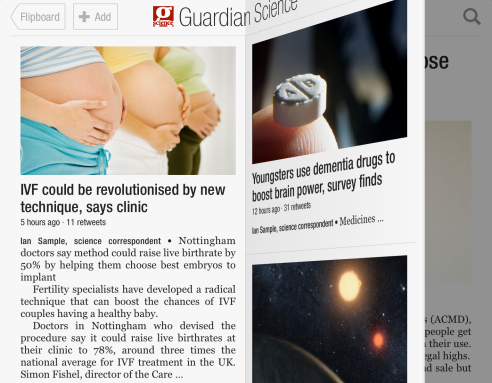Flipboard: a help or hindrance to publishers?
17 May, 13 | by BMJ
In the past month, almost 1 million new magazines have appeared on Apple’s iPad. Rather than heralding a long-awaited comeback from traditional publishers, nearly all of these collections of articles, photos and social-media updates are the handiwork of ‘armchair editors’, using a new tool from the social magazine app, Flipboard.
Magazines on Flipboard have previously been the products of those publishers participating in its official partner program. These partners include The Guardian, The New York Times and Forbes, to name but a few.
Flipboard 2.0, however, means that users can now create their own magazines rather than just subscribe to those created by established content producers. Other Flipboard users can also subscribe to these magazines, which will display the original sources for their content (thereby driving traffic to publisher sites), as well as comments from social networks.
We use social media to grow your audience by sharing your content with Flipboard users, who then share it with their friends. Flipboard provides a platform for deep content engagement across a growing audience of social influencers and enthusiastic readers. Our readers make over 10 million social recommendations a month via the app to their friends.
The obvious comparison to make here is to Pinterest, the site where people create ‘boards’ of images and videos that other users can then ‘repin’ onto their own boards. Swap boards and repin with ‘magazines’ and ‘flip’ and you have Flipboard 2.0.
Partners vs. users
So, how will people find these magazines? Another feature known as Content Search has been introduced that enables users to search by topic, person or hashtag. There’s certainly an interesting line to be walked between promoting the magazines from paying media partners and surfacing the best grassroot contributions.
“We will surface partners’ content more prominently in search results,” said Flipboard CEO Mike McCue. “But we are trying to find the right balance between curation, and providing the search and other mechanisms to bring in content from other sources.”
Working with publishers
Flipboard wants to offer publishers more than a platform to distribute and curate content; it also wants to help publishers monetise their content.
“If you’re Burberry or Gucci, you’re not going to run a banner ad,” McCue said. “To get brand ad dollars to move to digital, you need to create a beautiful experience.” He believes that Flipboard can build that kind of experience, enabling publishers to better monetise their content by creating a place where brand advertisers can buy beautiful, full-page ads. There is also talk of publishers selling their content direct to consumers through Flipboard, either through subscriptions or even selling individual pieces of content.
Friend or foe?
The new product has been behind a massive increase in the number of people who use the app. Subscribed users are now up to 56 million users with 6 million added in the past month. While many of the features of Flipboard 2.0 will be appealing to publishers, including the promise of content sharing, traffic referrals and now advertising revenue, some commentators are cautioning against jumping into bed with the app too enthusiastically:
The reality the publishing needs to understand…is that Flipboard has (smartly) maneuvered itself into a powerful position. With the flick of a switch, it could deal a serious blow not only to the traditional old media but also to a variety of digital platforms – Tumblr, Flickr, WordPress, among others – as it pivots from purely curation-based interaction to one that offers users full-blown creation abilities. Indeed, this is likely its only future, since without the agreement of the major content creators, Flipboard would be little more than a collection of Tweets and blog posts.
http://www.youtube.com/watch?v=I9dv5QVs2_c&feature=player_embedded
